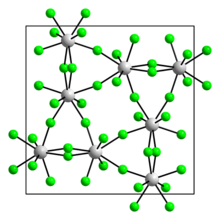Uranium pentafluoride is the inorganic compound with the chemical formula UF5. It is a pale yellow paramagnetic solid. The compound has attracted interest because it is related to uranium hexafluoride, which is widely used to produce uranium fuel. It crystallizes in two polymorphs, called α- and β-UF5.
 β form
| |
| Identifiers | |
|---|---|
3D model (JSmol)
|
|
| ChemSpider | |
| ECHA InfoCard | 100.033.991 |
| EC Number |
|
PubChem CID
|
|
| UNII | |
CompTox Dashboard (EPA)
|
|
| |
| |
| Properties | |
| UF5 | |
| Molar mass | 333.02 g/mol |
| Appearance | Pale yellow crystalline solid |
| Density | 5.823 g/cm3 (alpha polymorph) |
Except where otherwise noted, data are given for materials in their standard state (at 25 °C [77 °F], 100 kPa).
| |
Synthesis and structure
editUranium pentafluoride is an intermediate in the conversion of uranium tetrafluoride to volatile UF6:
- 2 UF4 + F2 → 2 UF5
- 2 UF5 + F2 → 2 UF6
It can be produced by reduction of the hexafluoride with carbon monoxide at elevated temperatures.[1]
- 2 UF6 + CO → 2 UF5 + COF2
Other reducing agents have been examined.[2]
The α form is a linear coordination polymer consisting of chains of octahedral uranium centers in which one of the five fluoride anion forms a bridge to the next uranium atom.[3] The structure is reminiscent of that for vanadium pentafluoride.
In the β form, the uranium centers adopt a square antiprismatic structure.[4] The β polymorph gradually converts to α at 130 °C.[3]
Monomeric UF5
editOf theoretical interest, molecular UF5 can be generated as a transient monomer by UV-photolysis of uranium hexafluoride. It is thought to adopt a square pyramidal geometry.[5]
References
edit- ^ Gordon W. Halstead, P. Gary Eller "Uranium(V) Fluorides and Alkoxides" Inorganic Syntheses 1982, volume 21, 162. doi:10.1002/9780470132524.ch35
- ^ Eller, P. G.; Larson, A. C.; Peterson, J. R.; Ensor, D. D.; Young, J. P. (1979). "Crystal Structures of α-UF5 and U2F9 and Spectral Characterization of U2F9". Inorganica Chimica Acta. 37 (2): 129–133. doi:10.1016/S0020-1693(00)95530-0.
- ^ a b Howard, C. J.; Taylor, J. C.; Waugh, A. B. (1982). "Crystallographic Parameters in α-UF5 and U2F9 by Multiphase Refinement of High-Resolution Neutron Powder Data". Journal of Solid State Chemistry. 45 (3): 396–398. Bibcode:1982JSSCh..45..396H. doi:10.1016/0022-4596(82)90185-2.
- ^ Taylor, J. C.; Waugh, A. B. (1980). "Neutron Diffraction Study of β-Uranium Pentafluoride Between 77 and 403 K". Journal of Solid State Chemistry. 35 (2): 137–147. Bibcode:1980JSSCh..35..137T. doi:10.1016/0022-4596(80)90485-5.
- ^ Onoe, J.; Nakamatsu, H.; Mukoyama, T.; Sekine, R.; Adachi, H.; Takeuchi, K. (1997). "Structure and Bond Nature of the UF5 Monomer". Inorg. Chem. 36 (9): 1934–1938. doi:10.1021/ic961237s. PMID 11669800.